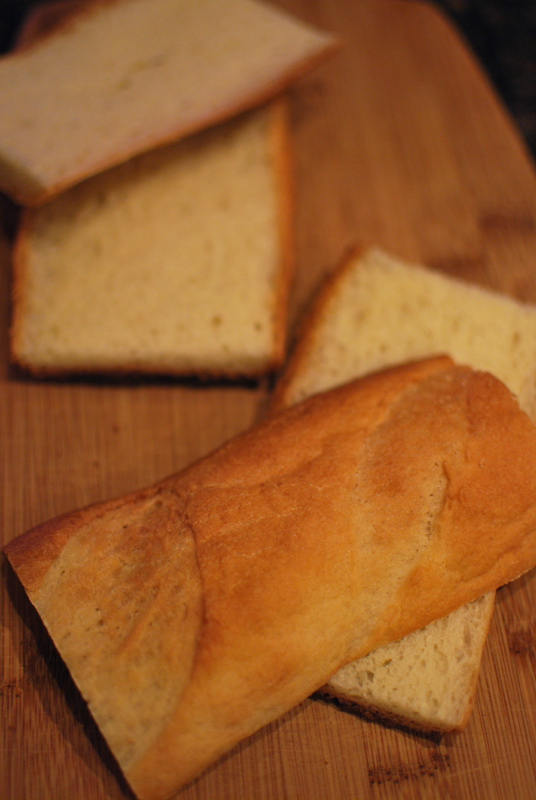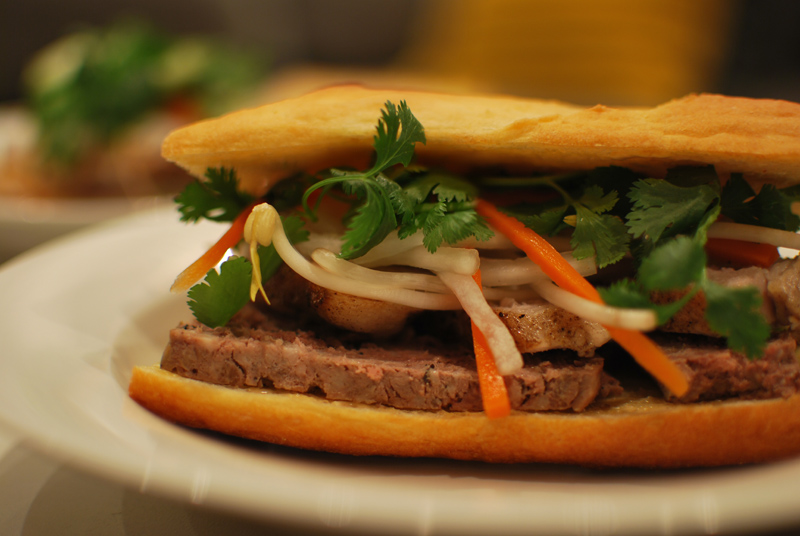Week Thirty-Five: East Asian Breads
Whenever I find a new food that strikes my fancy, I immediately begin to crave it. Incessantly. Unflinchingly. Unapologetically. It’s all I want to eat, for every meal if possible. When it comes to new cuisines that impress me, I want to learn – with my tongue – as much as possible about that cuisine. This means that I’ve led my family and friends through some very, shall we say, interesting culinary experiments over the years.
Such was my state of mind when I discovered Vietnamese food for the first time. A friend led me to a charming hole in the wall, replete with slightly sticky chairs, paper lanterns, and fluorescent lights, the kind of place you know has either the best food or the absolute worst. (Luckily for me, it was the former.) It’s where I discovered my beloved Sriracha, that blazing wonder of the condiment world. The monster bowls of brothy phở enchanted me, full of new and unfamiliar flavors, and the sticky, stretchy skin of gỏi cuốn (spring rolls) began to haunt me whenever I hungered.
From this gateway, I eventually learned about bánh mì [bun mee], that ubiquitous gem on every Vietnamese restaurant’s menu. A culinary relic from the period of French occupation, a banh mi is a sandwich that combines the French – baguette, pâté, mayonnaise – with the Vietnamese – cilantro, fish sauce, pickled carrot and daikon radish.
The result is far more than the sum of its parts. By turns meaty, crunchy, crisp, herbal, spicy, and pungent, it’s difficult to describe the total effect contained in each bite; it is surely one of the world’s great sandwiches. The standard banh mi is made with pork and pork liver pâté, but many equally tasty variations exist.
Banh mi ga is a common example, made with chicken and chicken liver pâté, while other versions made with meatballs, beef, tofu, and egg are seen just as often. All are typically garnished with mayonnaise, fish sauce, cilantro, jalapeño, and pickled carrots and daikon radish. Part of the charm is the wide variety of delicious flavors, but another main attraction is the inevitably cheap price tag; it’s rare to see a banh mi go for more than $4, in my experience.
Most of the time, recipes for banh mi call for “a crusty French baguette”. This is not quite accurate, however, as a proper banh mi is made with a Vietnamese baguette. The difference, though seemingly insignificant, lies in the flour. Vietnamese baguettes use a percentage of rice flour in addition to the wheat flour. This was undoubtedly due originally to economy and availability, but the effect is unique and lovely. The rice flour gives the otherwise airy and crusty baguette a bit of stickiness, a characteristic chewiness beyond the familiar pull of wheat gluten.
Many Vietnamese restaurants in America have unfortunately begun to use more readily available (and most likely cheaper) all-wheat, commercially-made “baguettes”, bread that removes part of the soul of a banh mi sandwich. Happily, there are enough Vietnamese bakeries around that quality rice flour baguettes are in no danger of extinction, and many restaurants pride themselves in the support of their own community by using them.
As for my own rice flour baguettes, they were not very successful. Dreams of airy and freshly-made banh mi dancing in my head, I became distracted, and accidentally let the dough over-proof. Twice. Yes, somehow I forgot about it during both rises. This resulted in a couple of sad, flat baguettes emerging from my oven, not the round and cheerful ones I had imagined. The texture was even but not ideal, and I think the relatively high percentage of rice flour wasn’t helping matters either; I want to give this recipe another more careful try, with a slightly reduced amount of rice flour, before I make a final judgement as to its success or failure.
But otherwise, the sandwiches were nothing short of exquisite. Delightfully sticky, these thin baguettes happily cradled the chosen fillings of pork, peppercorn pork liver pâté, quickly-made carrot and daikon pickles, and the other requisite accoutrements, which I’ve detailed below. To integrate the fish sauce and Sriracha more evenly, I mixed them into the mayonnaise, an application that worked flawlessly. I would certainly use that spicy, robust “banh mi-onnaise” in many other applications; curried chicken salad with raisins comes instantly to mind.
Overall, these were perhaps not the most intensely amazing banh mi I’ve ever had, but it was purely the fault of the bread itself, and therefore my own. I don’t think there’s any such thing as a bad banh mi, assuming the ingredients are chosen with a modicum of sense and an eye for freshness. Will I be eating banh mi again tonight, with the same bread, using the fillings leftover from yesterday? Oh my, yes; and I’ll be enjoying every last little mote as though it were the first time.
Banh Mi Bread
Adapted from The Foppish Baker and Rice and Wheat
Makes 2 regular-size baguettes
9 ounces (2 cups) unbleached all-purpose flour, divided, plus extra as needed
5 ounces (1 scant cup) very fine rice flour
2 teaspoons yeast
2 teaspoons sugar
1 1/2 teaspoons salt
1 cup water, at room temperature
2 tablespoons unsalted butter, at room temperature
1. In the bowl of a stand mixer, whisk together 1 cup of the all-purpose flour, all of the rice flour, yeast, sugar, and salt. Add the water. Using the paddle attachment, mix at low speed until thoroughly blended, about 1 to 2 minutes.
2. Switch to the dough hook, and continue mixing at low speed. Add enough of the remaining all-purpose flour until a moderately stiff dough forms; you may need more or less than the reserved 1 cup. The dough should clear the sides of the bowl, but not be too stiff. Increase the speed to medium-low, and continue kneading for 7 to 8 minutes, or until the dough is smooth and elastic. Decrease the speed to low, and add the softened butter in small pieces. Let each piece incorporate before adding the next.
3. Transfer the dough to a large, lightly-oiled bowl. Cover tightly with plastic wrap, and let sit at room temperature until doubled in size, about 45 to 60 minutes.
4. Turn the dough out onto a lightly floured surface, and divide into two equal pieces. Shape each into an round ball, then into an oblong loaf shape. Cover again, and let rest for about 10 minutes. Lightly grease a large baking sheet, or line with parchment paper.
5. Working with one piece at a time, and keeping the other covered, gently press each piece into a flat oval. Starting with a long side, roll up into a long cylinder. Set aside, covered, while shaping the other piece.
6. Rolling underneath flat palms, or pulling gently as needed, lengthen each piece into a long, thin rope, about 18 to 20 inches long. Transfer carefully to the prepared baking sheet. Cover loosely with lightly oiled plastic wrap, and let rise for 45 to 60 minutes, or until doubled in size. Thirty minutes before baking, preheat the oven to 450º F, and place another baking sheet or oven-safe pan on a rack in the bottom third of the oven. Or, if you have a baking stone, use it instead, heating it with the oven.
7. Using a sharp serrated knife or clean razor blade, make 3 or 4 decisive slashes in the top of each loaf at a 45º angle, evenly spaced. If it deflates, let it recover for an additional 10 to 15 minutes. Spray or sprinkle the bread with water, and transfer the bread to the oven (or baking stone, if using). Bake for 5 minutes, spraying the dough with water every minute or two.
8. After 5 minutes, reduce the temperature to 400º F, and continue baking for an additional 10 to 15 minutes, or until deeply golden brown and fully baked. An instant-read thermometer should register about 205º to 210º F when inserted into the center. Remove the bread to a wire rack to cool fully before slicing.
Banh Mi (Vietnamese Pork Sandwiches)
Makes 3 to 4 sandwiches
1 loaf banh mi bread, recipe above
Banh mi-onnaise, recipe below
Pickled carrots and daikon radish, recipe below
8 ounces pork loin, cooked and sliced
4 to 6 ounces pork liver pâté, sliced
Bean sprouts, about 1 cup
1 jalapeño, sliced thinly
Cilantro leaves, to taste
Salt and black pepper, to taste
Extra fish sauce and Sriracha, to taste
Lime wedges, for squeezing
1. Slice the loaf of bread in half horizontally. Toast briefly under a hot broiler until lightly crispy.
2. Spread both cut sides of the bread with banh mi-onnaise. Top bottom half with (in order) slices of pork loin, slices of pâté, pickled carrot and daikon, bean sprouts, jalapeño, and cilantro. Add salt, pepper, sriracha, fish sauce, and lime juice to taste. Top with other half of bread, cut into 3 or 4 pieces, and serve.
Banh Mi-onnaise
Makes about 1/4 cup
4 tablespoons mayonnaise
1/2 teaspoon fish sauce
1/2 teaspoon Sriracha
1/4 teaspoon soy sauce
1. Mix all ingredients together until smooth. Refrigerate until needed.
Pickled Carrots and Daikon Radish
Adapted from Viet World Kitchen
Makes about 2 cups
For the brine:
1/2 cup sugar
1 1/4 cups distilled white vinegar
1 cup water
1/2 teaspoon whole black peppercorns
1 bay leaf
For the vegetables:
1 large carrot, peeled and cut into thin matchsticks
1/2 pound daikon radish, each no larger than 2 inches in diameter, peeled and cut into thin matchsticks
2 teaspoons sugar
1 teaspoon salt
1. Combine all the brine ingredients in a pan over medium-high heat. Heat, stirring, until all the sugar is dissolved. Remove from heat, and let steep while preparing the vegetables.
2. Place the cut carrot and daikon in a non-reactive bowl, and sprinkle with the salt and sugar. Using your hands, squeeze and knead the vegetables for about 3 minutes. They will release liquid and begin to soften. Stop kneading when you can bend a piece of daikon so that the ends touch, but does not break. Drain and rinse the vegetables with cold water in a colander. Gently squeeze excess liquid off.
3. Return the vegetables to the bowl, or place in a clean jar for longer storage. Pour the brine over the vegetables. The brine should totally cover the vegetables; if not, add extra water until covered. Place a piece of parchment paper on the surface of the brine to keep the vegetables moistened, and cover with plastic wrap, or a lid.
4. Let the vegetables sit for at least 1 hour before eating. If eating immediately, the curing action will happen faster at room temperature. If eating within a day or two, they should be refrigerated. They will keep, refrigerated, for up to 4 weeks.
Notes:
1. For the bread dough, be sure to use the finest-milled rice flour you can find. Bob’s Red Mill is a good and widely-avaliable choice; Arrowhead Mills is a bit coarser. Any Asian market should have at least one option.
2. It’s not necessary to use the pickled vegetables, and the banh mi-onnaise can just as well be switched for regular mayonnaise. But they do lend a bit of authenticity to the flavor; proceed at your discretion.




Can you use glutinous rice flour?
Havard bend: I don’t see why not. Give it a shot, and see what happens! Happy baking!